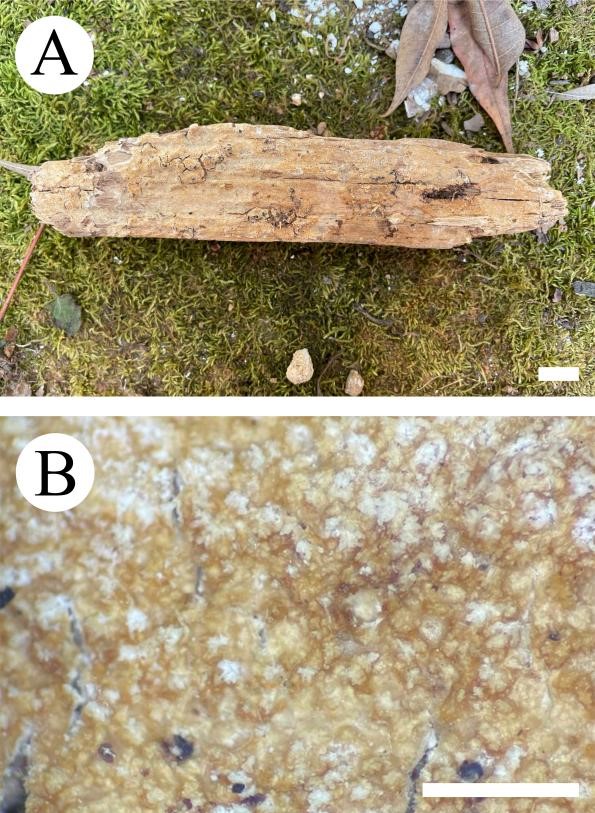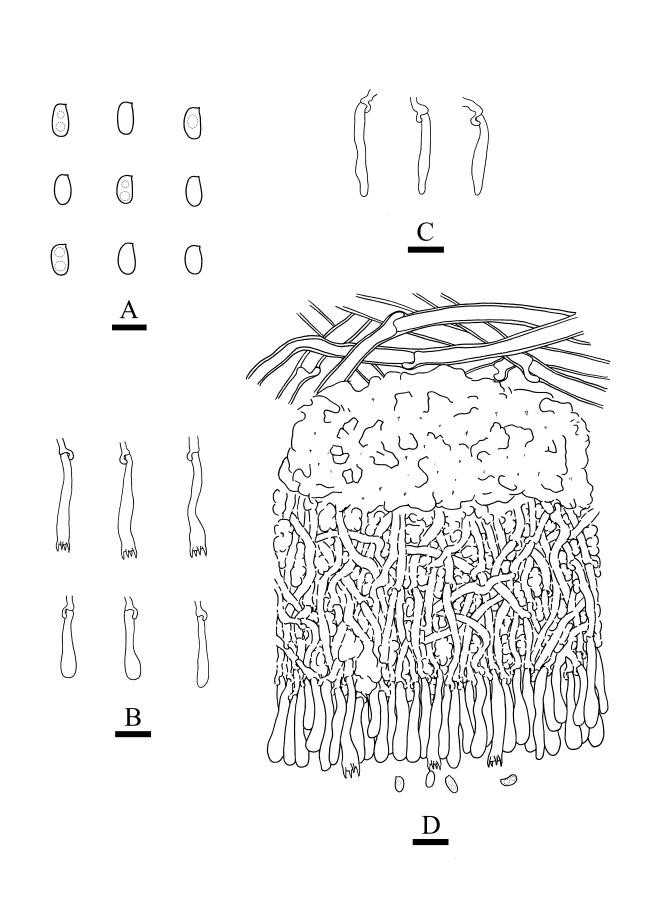Merulius sinensis Authority.
MycoBank number: MB 843319; Index Fungorum number: IF 843319; Facesoffungi number: FoF 12687;
Description
Basidiomata annual, resupinate, ceraceous, without odor or taste, when fresh, becoming coriaceous upon drying, up to 13 cm long, 3.5 cm wide, 100–300 µm thick. Hymenophore grandinoid, pinkish buff when fresh, peach upon drying. Sterile margin narrow, buff to peach. Hyphal structure monomitic; generative hyphae clamped, colorless, thin- to thick-walled, IKI–, CB–; tissues unchanged in KOH. Subicular hyphae thick-walled, unbranched, 4–5.5 μm in diameter; subhymenial hyphae unbranched, 1.5–3.5 μm in diameter; the presence of numerous larger golden gelatinous substances below subhymenium. Hymenium cystidia absent; cystidioles colorless, thin-walled, smooth, 18.7–26.4 × 2.3–3.5 µm; basidia cylindrical, with four sterigmata and a basal clamp connection, 19.7–29.2 × 2.9–4.5 µm. Basidiospores ellipsoid, colorless, thin-walled, smooth, often with 1–2 oil drops, IKI–, CB–, (3.6–)3.8–4.5(–4.7) × (1.8–)2–2.6 μm, L = 4.13 µm, W = 2.24 µm, Q = 1.85 (n = 30/1).
Material examined: China, Yunnan Province, Yuxi, Xinping County, Mopanshan National Forestry Park, E 102°48′, N 24°51′, alt. 1980 m, on the fallen branch of angiosperm, 20 August 2017, C.L. Zhao, CLZhao 2562 (SWFC).
Distribution: The species is known from Yunnan Province, China, in a subtropical evergreen broad-leaved forest. It grows on moderately decayed angiosperm wood and causes white rot.
Sequence data: ITS: MW732401 (ITS5/ITS4); LSU: MW724793 (LROR/LR7); GAPDH: ON892532 (GAPDH-F/GAPDH-R); mtSSU: MW732761 (MS1/MS2)
Notes: This species groups with Phlebia nantahaliensis Nakasone & Burds. (Fig. 2), but the latter distinguishes from Merulius sinensis by its very thin basidiomata and allantoid, narrower basidomata (4.5–4.5 × 1.8–2 μm, Nakasone & Burdsall 1995).

Fig. 1 Basidioma of Merulius sinensis (holotype). — Scale bars: A = 1 cm, B = 1 mm.

Fig. 2 Microscopic structures of Merulius sinensis (drawn from the holotype). A. Basidiospores; B. Basidia and basidioles; C. Cystidioles; D. A section of hymenium. — Scale bars: A = 5 μm, B–D = 10 μm.
